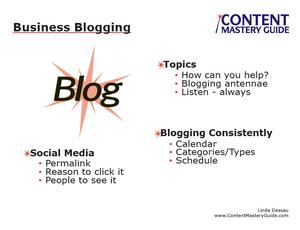
As a business blog writer and consultant, I hear many questions, starting with, “Can you actually make a living doing that?” With customers heading straight to the web to find solutions to their problems, online marketing is no longer an option, it’s a necessity. And that makes what I do a necessity as well.
Here are 10 answers that will help any business owner market more effectively and connect with your customers online. I’ve grouped them into the three themes of blog planning, blog writing, and blog promotion.
Blog planning
1. What is a blog? A blog is a special section of a website that you update frequently with articles, news, and stories. The newest updates appear at the top of the page, with the older ones below. Posts are also organized by category. Example: Ask the Real Estate Team (Barrie, ON).
2. Should I blog/Why should I blog? No one HAS to blog, and you shouldn’t start unless you’re committed to blogging regularly for at least six months to give it a chance to produce results for your business. Reasons TO blog:
- Stay visible to your audience so they think of you when they need your product or service. Example: Rooted Naturopathic Medicine Clinic (Barrie, ON).
- Demonstrate your expertise about topics related to your business. Example: Rhonda Sherwood, Wealth Advisor for Scotia McLeod (Vancouver, BC).
- Produce original content you can share on social media, to accomplish the first two goals in a variety of settings. Example: Summit Insight (Alexandria, VA)
- Follow up with new contacts and prospective customers with links to information you’ve already written about questions they had.
3. Where should I blog? Recommended: Integrated into your own business website (Sample: Litchfield Builders, Hamden, CT). Next best thing: A separate site with the same branding, your own domain name, and clear links back and forth from the main site (Sample: Chilis). Not recommended: Blogging on “borrowed land,” like Blogger/Blogspot, WordPress.com, or Tumblr.
4. What should I blog about? A business should blog about things that will be interesting, relevant and helpful to your ideal customers. Start with a list of categories or themes you’ll write about. This helps you stay organized, and it also helps your readers find the answers they’re looking for.
Blog writing
5. How long and how often? While we’re hearing more now about the effectiveness of 1,000+-word blog posts, I still suggest that new business bloggers aim for 500 words for their feature articles. That being said, if you have more to say, and the additional words are purposeful and well-written, you no longer need to cut off your writing or arbitrarily divide it into multiple posts (for example, I’ll definitely need more than 500 words to answer these 10 questions!) For different types of posts (see the next answer for examples), 250-300 words is plenty.
6. Where do I find the time to blog? Blog posts don’t always have to be text-heavy or 100% original content, and these alternate types of posts can be quicker to write. For example, you can interview an expert about a topic that’s relevant to your customers, introduce or summarize a video or audio (your own or someone else’s), or review a book. (Here are some other blogging time management tips inspired by my greyhound Patch.)
7. Is it okay to copy someone’s article if I give them credit? No. Giving credit does not equal permission. You can quote one or two lines, but any more than that and you need explicit permission from the author. It’s better to just write some original commentary about why you like or recommend the content, then provide a link. (More suggestions about business blogging etiquette.)
Blog promotion
8. How do I get people to see my new blog posts?
- Copy your post’s permalink (permanent link) from your web browser’s address bar (here is a video about how to find the permalink).
- Paste the link into a status update box on a social media site, and then…
- Add a brief teaser that tells the reader why they should read your post and how it will benefit them. Be consistent with the culture and norms of each network (e.g., you’re limited to 140 characters on Twitter, so don’t automatically copy the same message you’ve written for Facebook or it will be cut off and won’t make a good impression on your Twitter followers). Some titles, like this one by Debbie Ouellet (Barrie, ON), are compelling enough to use on their own (note that it already includes a question)! Your brand is a country. What’s it like to live there?
- Email the link to someone directly if it’s a topic you discussed or you think they would enjoy/benefit from. (WiseStamp is an email signature tool that can automatically pull in the title and link of your latest blog post.)
9. How can I make my posts stand out on social media? Even with a catchy teaser, you still need to get people to notice that amidst everything else that’s constantly flowing into their social media streams. A colourful, attention-grabbing photo is the key to getting people to read even that short text, let alone click the link to read the whole post. Tip: On Facebook and Google+, upload a photo first, before you type your teaser and paste in your permalink. That way readers will see a full-sized photo rather than a thumbnail. [Update: July 17, 2015 – As of November 2014, Facebook is giving more visibility to posts that contain links with thumbnail images, versus those with uploaded photos.]
10. Where can I find photos to use legally? Just as you can’t reprint other people’s text, you also can’t automatically use other people’s photos without permission. To find photos you can share, I recommend Stock Exchange (free) – http://www.sxc.hu/, Photopin (free) – photopin.com and Fotolia (fee-based) – fotolia.com.
Thanks to the organizers and attendees of Small Business Connect in Barrie, Ontario, where I presented this information (with some technical difficulties). I’m glad to be able to deliver all the links and examples I promised!
Did you find this post useful? Please send one of these messages to your Twitter followers, or use the social sharing links below for LinkedIn, Facebook, or Google+.


 Effective business blogging requires you to plan and create content that is relevant, meaningful and helpful to your audience. Behind the scenes, however, there are many other tasks that ensure your post will do its job of effectively attracting new customers for your business. Luckily, you don’t have to do all of them yourself!
Effective business blogging requires you to plan and create content that is relevant, meaningful and helpful to your audience. Behind the scenes, however, there are many other tasks that ensure your post will do its job of effectively attracting new customers for your business. Luckily, you don’t have to do all of them yourself! Being active on social media can seem like a lot of work. Many business owners wonder how much they can automate or outsource without being robotic or fake. In Part One of a
Being active on social media can seem like a lot of work. Many business owners wonder how much they can automate or outsource without being robotic or fake. In Part One of a 